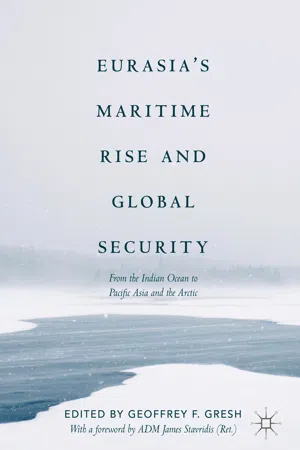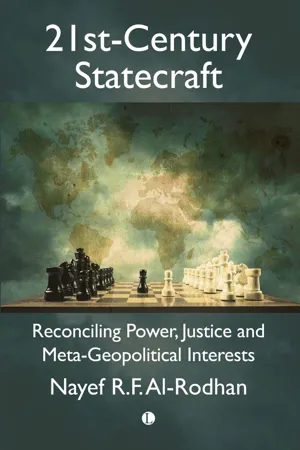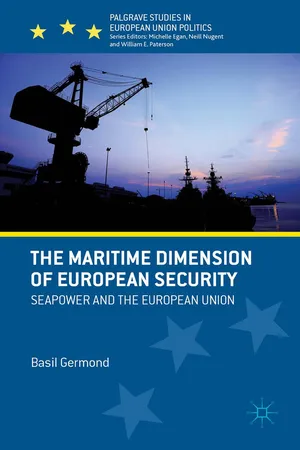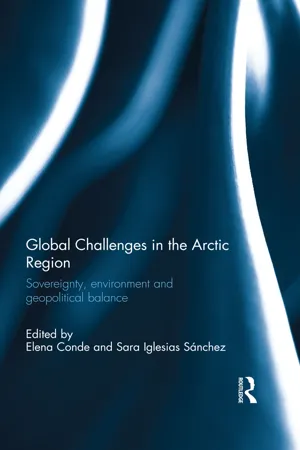Geography
Choke Point
A choke point is a narrow passage or channel that serves as a strategic point of control for maritime or land transportation. It can be a natural feature, such as a strait or canal, or a man-made structure like a bridge or tunnel. Choke points have significant geopolitical and economic importance due to their impact on trade and military access.
Written by Perlego with AI-assistance
Related key terms
1 of 5
5 Key excerpts on "Choke Point"
- eBook - ePub
Eurasia’s Maritime Rise and Global Security
From the Indian Ocean to Pacific Asia and the Arctic
- Geoffrey F. Gresh(Author)
- 2018(Publication Date)
- Palgrave Macmillan(Publisher)
Straits, (ii) the Suez Canal, and (iii) the Strait of Gibraltar—by providing a brief historical summary of how each waterway has evolved over time, and then concludes by exploring possible reasons why strategic chokepoints are important to certain maritime industries but not others.Strategic Maritime Chokepoints
Although the world ocean covers over 70 percent of the globe, commercial shipping routes are remarkably concentrated. Strategic chokepoints are narrow waterways where sea routes converge due to geography, including straits, capes, canals, and passages. The modern shipping industry’s focus on speed and efficiency causes international trade flows to merge in the following strategic waterways: the Malacca Straits, the Strait of Gibraltar, the Suez Canal, the Turkish Straits, Bab al-Mandab , the Strait of Hormuz , the Cape of Good Hope, Cape Horn , the Bering Strait , the English Channel , the Danish Straits , the Panama Canal , and the Windward and Mona Passages . Each maritime chokepoint has a different strategic significance depending on its geography, history, infrastructure, and availability of alternative sea routes.The importance of strategic chokepoints has varied throughout human history, evolving with technological improvements and changing patterns of human movement. The development of advanced naval weaponry allowed European nations, and later America and Japan, to expand their influence around the globe. The establishment of colonial empires motivated European powers to secure their trade routes with strategic naval outposts, such as the British in Singapore. The increasing importance of seaborne trade over the last three centuries fueled the struggle to retain control over such chokepoints. The growing dependence of modern navies on coal - No longer available |Learn more
21st-Century Statecraft
Reconciling Power, Justice and Meta-Geopolitical Interests
- Nayef Al-Rodhan(Author)
- 2022(Publication Date)
- The Lutterworth Press(Publisher)
A short description of the area’s Choke Points will follow in order to provide more detail about the region’s geostrategic features. 10.1.1 Countries and Regions in the TPC The following countries and regions are found within the TPC’s longitudinal band: Afghanistan Antarctica Arctic Circle Armenia Azerbaijan Bahrain Belarus Burundi China (Xinjiang province) Djibouti Egypt Eritrea Ethiopia Georgia India (Jammu and Kashmir) Iran Iraq Israel and the Palestinian Territories Jordan Kazakhstan Kenya Kuwait Kyrgyzstan Lebanon Madagascar Maldives Mozambique Oman Pakistan Qatar Russian Federation Rwanda Saudi Arabia Seychelles Somalia South Africa Sudan Swaziland Syria Tajikistan Tanzania Turkey Turkmenistan Uganda Ukraine United Arab Emirates Uzbekistan Yemen Zambia Zimbabwe 218 21st-Century Statecraft 10.1.2 Choke Points Choke Points are narrow international waterways that a number of states depend on for trade and military purposes. Because they are narrow, they can easily be closed off to shipping. Because of the lack of an alternative maritime route, the blockage of a Choke Point can have serious economic and military implications for states that depend on these maritime passageways. Indeed, maritime transport is the backbone of world trade and petroleum imports. 6 Hence, it is of vital importance for the global economy that these key sea lanes remain open. Powerful states whose economic well-being depends on these passageways have tried to maintain influence over these key areas, mostly by cultivating friendly relations or forming alliances with states bordering the Choke Points. For the United States, keeping these passageways open is a crucial prerequisite for maintaining its overall global influence. Our TPC contains four major Choke Points: 1) The Strait of Hormuz is a narrow passageway that connects the Gulf of Oman and the Arabian Sea with the Persian Gulf. At its narrowest point, the strait is only about 34 kilometres wide. - eBook - ePub
The Maritime Dimension of European Security
Seapower and the European Union
- B. Germond(Author)
- 2015(Publication Date)
- Palgrave Macmillan(Publisher)
The implementation of the ‘concentric circles’, ‘forward presence’, and ‘maritime backyard’ strategies is, to some extent, dependent on the control of certain maritime chokepoints. These positions (usually straits, canals, or peninsula) command access to certain portions of the oceans. They are usually located along important SLOCs where they constitute a point of congestion. Examples include the Strait of Malacca (and the Kra Isthmus), the Strait of Hormuz, the Bab-el-Mandeb Strait, the Suez Canal, the Panama Canal, the Cape of Good Hope, and Cape Horn. With the melting of the polar ice cap, the geostrategic importance of the Bering Strait is also likely to grow. The strategic importance of chokepoints has given birth to a specific geopolitical subdiscourse, which emphasises the need to either control those chokepoints or at least make sure no one else can control them exclusively, so as to secure one’s own use of the sea as a means of transportation and communication. A recent example can be found in China’s ‘string of pearls’ narrative, which represents the sea route from China to the Indian Ocean as vital for China’s economic and energy security and thus legitimises China’s acquisition of (or access to) naval facilities along it: in the Spartly Islands, Cambodia, Thailand, Myanmar, Bangladesh, Sri Lanka, Maldives, and Pakistan (Pant, 2012: 365). That said, China’s ‘expansionist’ maritime narrative is still balanced by the ‘Zhang He’ narrative, which rather puts the emphasis on China’s benign intentions. Indeed, Ming Dynasty Admiral Zhang He’s travel and sojourn ‘in maritime Asia without attempting military conquest [is used as] a metaphor for China’s current peaceful ascent in the maritime domain’, including in the Indian Ocean (Yoshihara, 2010).***Geography does constrain politics in general and seapower in particular, at least to a certain extent and in conjunction with ideational factors. In turn, states have developed geopower politics, whose maritime dimension has always been crucial. Maritime geopower politics have been normalised through a series of geopolitical representations, which, although they have varied over time and between places, recurrently put the emphasis on the need to control the seas so as to, eventually, control the land. The following chapter will discuss the role of naval forces in fulfilling seapower politics. Chapters 4 and 5 - eBook - ePub
Maritime Strategy and Sea Control
Theory and Practice
- Milan Vego(Author)
- 2016(Publication Date)
- Routledge(Publisher)
8 Choke Point controlDo you know that there are five keys to theworld? The Strait of Dover, the Straits ofGibraltar, the Suez Canal, the Straits ofMalacca, the Cape of Good Hope. Andeveryone of these keys we hold.Aren’t we the lost tribes?Admiral John Fisher (1841–1920)1Straits, or “Choke Points,”2 have had a very great importance in the struggle for sea control throughout the ages. Choke Point control is only the first, although the most important step, for obtaining control of a given enclosed or semi-enclosed sea theater. Hence, a stronger side should be operationally and tactically on the offensive; otherwise, having control of a Choke Point is of little value or even essentially useless.A stronger side at sea could exercise operational or even strategic control of a given enclosed or semi-enclosed sea by virtue of its possession of one or both shores of an important strait/narrows, either already in peacetime or obtained in the course of hostilities. A more difficult situation for a stronger side is when control must be obtained by blockading the approaches to a Choke Point controlled by a weaker opponent.Straits are both the hubs and the most vulnerable segments of sea communications. A stronger side, by possessing physical control of either a strait or its approaches, is able to control naval/commercial movements of all powers to/from a given enclosed or semi-enclosed sea. Control of one shore or, preferably, both shores of a strait/narrows in peacetime greatly enhances one’s ability to obtain control of the adjacent sea or ocean areas soon after the outbreak of hostilities. The control of a strait/narrow includes control not only of the water but also of the adjacent land area and associated airspace.Importance
There are several hundred straits worldwide, and most of them are important only to a certain littoral state. However, some straits have “international” importance because their significance transcends the interests of the littoral states. The number of international straits varies from 95 to 121.3 International straits are free for navigation by ships of all nations, regardless whether they overlap with the territorial waters of littoral states. Normally, various international agreements regulate the transit of naval vessels and commercial shipping through these straits in peacetime.4 - eBook - ePub
Global Challenges in the Arctic Region
Sovereignty, environment and geopolitical balance
- Elena Conde, Sara Iglesias Sánchez(Authors)
- 2016(Publication Date)
- Routledge(Publisher)
We are likely to witness a race to gain access to port facilities along the Siberian coast similar to the one that we are seeing in the Indian Ocean. Land communications between China and Western Europe, like the train which ran from China to Spain in December 2014 for the first time in history, will add to the shrinking of the Eurasian continent in terms of traveling time.Never mind political union, if Mackinder lived today, he would be warning about the geostrategic consequences of open and free markets within the core of Eurasia. Physical or political interdiction of the routes which might allow for this union would be the logical—and historically most likely—response to it.The disappearance of some insular territories and shifting baselines will no doubt result in disputes well beyond the Arctic Circle. Climate change calls for a comprehensive approach to international law and a flexible and cooperative new design of international relationships, because climate change itself knows no boundaries.An end to rivers without an end?
We have already discussed several different ways in which geography is relevant to the development of power and the creation of nations. In fact, geography dictates that there are regions in the world which are and will always be crossroads at which civilizations tend to crash. Change the name of the different actors involved, but clashes appear to be present at such places as the Balkans or Palestine.If you draw straight lines on a map between the different regional powers, the area contained in the resulting parallelogram is likely to be a contested one. Take the Russian, Persian and Ottoman empires, under whichever name they adopted throughout history, and the intersection of the lines joining them is where the Caucasus lies. For all three, this is and will be a region of special interest.Likewise, as already defined even before Alfred T. Mahan’s work on the influence of maritime power, a handful of Choke Points are the only vital areas needed to be controlled to gain mastery of the seas. There are sixteen traditional such points which have proved resilient to changing political situations.
Index pages curate the most relevant extracts from our library of academic textbooks. They’ve been created using an in-house natural language model (NLM), each adding context and meaning to key research topics.




